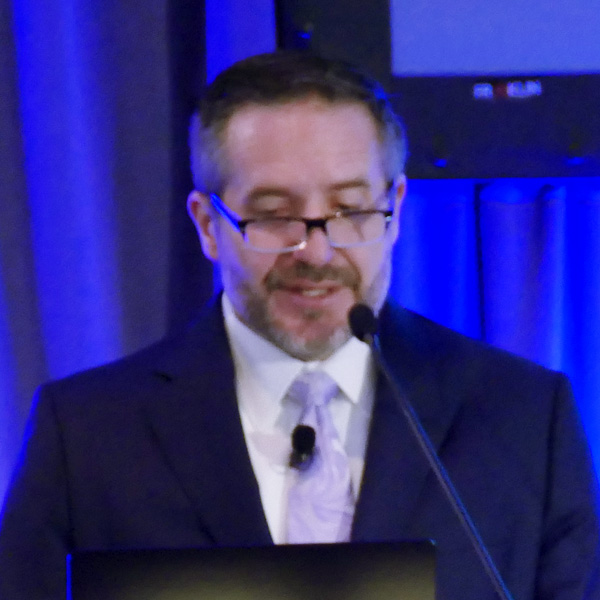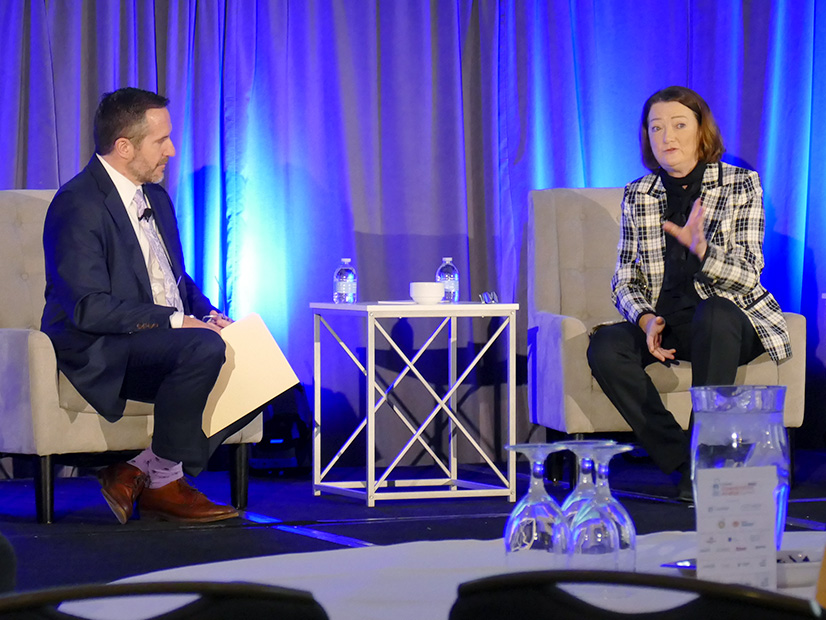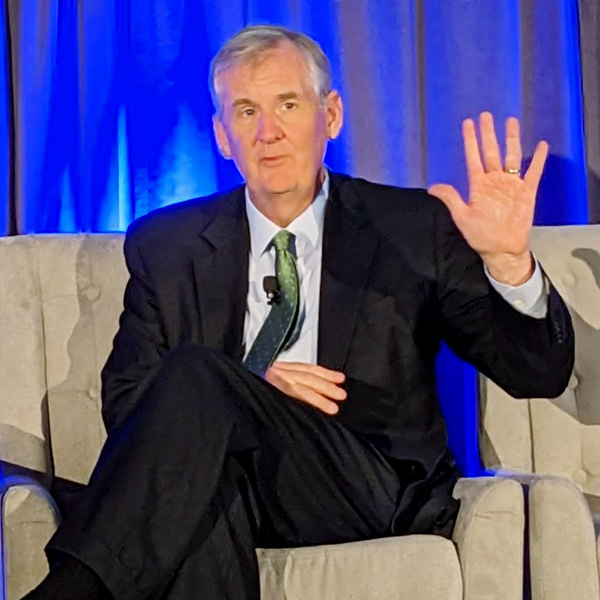WASHINGTON — The energy transition still presents some key hurdles that need to be overcome for it to occur successfully, speakers said at Electric Power Supply Association’s (EPSA) Competitive Power Summit on Tuesday.
“We need to think broadly about how we can collaborate to ensure reliability,” EPSA President Todd Snitchler said. “We’re looking at working through a period of energy expansion, not merely passively watching an energy transition.”
Getting to 100% renewable power plus electrifying key new areas of demand such as home heating and transportation means the industry will have to build more supply than it has now as it cleans up its generation stack, he added.
 EPSA President Todd Snitchler addresses the conference. | © RTO Insider LLC
EPSA President Todd Snitchler addresses the conference. | © RTO Insider LLC“Reliability has been a top priority for as long as competitive markets have been in place, but competing interests from policymakers and regulators have drawn attention away from that first responsibility,” Snitchler said.
NERC CEO Jim Robb noted that the industry has been through a number of high-profile events in recent years that have kept his organization busy, from winter freezes to physical attacks on grid infrastructure.
“Many of the issues and challenges that we’re starting to see are really coming at us through the generation side of the business, which is a little bit different than what we dealt with when the ERO was originally stood out in the mid-2000s,” Robb said. “And those issues are particularly around fuel supply and energy production.”
The key challenge facing the grid is reliably transitioning to a more intermittent resource mix while preserving the key reliability services that traditional, synchronous power plants provide. The grid’s dependence on natural gas and the lack of coordination were “exposed in Technicolor” during the outages in Texas and its neighboring states in February 2021, Robb said.
“Managing the pace of this transition is going to be key to being able to navigate it successfully,” Robb said. “And we’ve seen, through our reliability assessments, a steady decline in the risk profile of the sector of the last five years. And that’s in spite of a very strong aggregate performance, but the risks are clearly growing.”
Extreme weather is becoming more commonplace, and that has huge impacts on demand, especially in markets that use electricity for heat.
“Once the temperature drops to a point where heat pumps can perform, and you switch to electric resistance heating, the demand goes pretty much vertical,” Robb said. “That I think is going to be one of the main headlines coming out of our inquiry into Winter Storm Elliott,” referring to the storm that led to outages in the Southeast over the holidays late last year.
The changing grid also means that weather has a greater impact on generation, as too little or too much wind can knock out power from that renewable resource, or snow and clouds can block sunlight from reaching solar panels.
NERC has recently implemented winterization standards that it started after a cold snap in 2018 and were updated after the winter storm of February 2021.
Robb said that NERC needs to step up the pace of developing new standards so it can adequately respond to the changing grid, but efforts at streamlining the standards development process hit a snag earlier this month when a set of proposed changes to the organization’s Standards Processes Manual (SPM) failed on its first ballot. He said that industry stakeholders had not been particularly constructive in that effort.
“Our goals here are to speed the process, eliminate low value-added time sinks; actually maintain stakeholder engagement, stakeholder ownership of the outcomes; and we do want to give the board the authority to set meaningful deadlines to move things along,” Robb said.
The proposed SPM changes included creating a tiered system of comment periods, under which the initial 45-day comment and balloting periods would be followed by shorter comment periods. Another significant change would have removed the requirement for a final ballot to confirm the results of the most recent successful ballot, if the standard drafting team (SDT) felt that no further “substantive changes” were needed. (See NERC Standards Process Changes Headed for Public Comment.)
The changes were approved by NERC’s Standards Committee in January, following an order issued by the Board of Trustees at its November meeting. Trustee Sue Kelly said in December that the board was trying to address concerns that NERC’s “deliberative” standards development process was not keeping up with the increasingly rapid pace of industry change. (See NERC Board Member Argues for Increased Authority.)
Industry rejected the proposed SPM changes by a significant margin, with 118 votes against and 76 in favor. Some commenters, such as the Northern California Power Agency (NCPA), said the revisions did not adequately address issues of “due process, openness and balance of interests, [which] are already problematic under current SPM rules.” NCPA also complained that “SAR [standard authorization request] drafting teams do not always appear to make an effort to resolve SAR objections” as the SPM currently requires.
Commenters also objected specifically to the proposed shortening of later ballot periods, with Andrea Jessup of the Bonneville Power Administration pointing out that “industry subject matter experts are all very busy and … need the full 45 days to allow time for” full review. Jessup said that reducing the time for comments “would likely cause less industry participation” in the process.
Referring to the idea of eliminating the final ballot, the Midwest Reliability Organization’s NERC Standards Review Forum said that “only language approved by industry should be considered by the Board of Trustees for approval,” a view echoed by multiple commenters. NCPA said it could only agree with the proposal if the SDT makes no changes to the standard that passed the final ballot, explaining that “one person’s … idea of ‘not making a substantive change’ may not always be consistent with entities that voted for the proposal prior to … change.”
LS Power Sees Much Work Ahead
LS Power Generation President Nathan Hanson argued that the industry was just getting started on the transition to cleaner energy.
“If you really step back and think how much progress we’ve really made facilitating the transition, either on the regulatory basis or even legislatively, I don’t think we’ve really made any ground, and we’re basically a year closer to having to manage the issues that are showing up at the grid in California and Texas, or PJM and New England, over the Christmas period,” Hanson said.
That changeover needs to happen in a reliable and affordable way to avoid any customer revolts, he added.
“We have legislation and regulations that are going to allow as many renewables into the space as we can. The question is … can you manage the grid when you do that?” Hanson said. “And I would argue we’re on the tip of being able to manage it effectively even right now.”
Keeping existing plants running is the cheapest way the industry can keep on balancing the grid, but that value is not coming through in many markets, leading to retirements of resources that could help maintain reliability even if they are only run rarely.
Robb also called out the RTOs, saying that they need to revisit their market rules in light of recent issues the industry has faced.
“RTOs really need to revisit their market rules and create some way through market incentives and compensation to synthetically recreate the obligation to serve that guided this industry for such a long period of time,” Robb said. “We allow too many decisions to be made based on probabilities, economic returns, the likely scenarios going forward; and those are great. And those work for 99% of the time. It’s that 1% though; if we get outside of that, we get into real trouble.”
Shell’s Comer Endorses the US Approach to Energy Transition
Shell Energy Americas President Carolyn Comer said her firm was well poised to move on the energy agenda and offered praise to the U.S.’ “carrot-heavy” policy approach to guiding the energy transition.
The main issue is getting clean sources of energy to scale up because as that work continues, demand is going to grow, with 2 billion more people expected by 2050 and demand for power expected to double globally in that same period, she said. Sometimes the arguments get too simplistic, such as pitting the transition to clean energy against affordability.
 EPSA CEO Todd Snitchler and Shell Energy Americas President Carolyn Comer | © RTO Insider LLC
EPSA CEO Todd Snitchler and Shell Energy Americas President Carolyn Comer | © RTO Insider LLC
“I would argue, actually, if we don’t clean up our act and we don’t deal with climate change, or we don’t tackle the environmental stresses that we’re causing, the cost will be greater than the cost of investing in clean technologies in the first place,” Comer said.
While there is usually no line item on a power bill, customers are paying for catastrophic climate events from wildfires in the West to the deep freeze that led to days of outages in Texas in 2021, she added.
The Inflation Reduction Act will help the industry move on the transition with a number of “carrots” in the form of tax breaks and other forms of investment in clean technologies.
“I think it’s the right way to go because it protects the industrial base at the same time as we actually embark on an accelerated energy transition,” Comer said. “And so, I think it’s actually kind of leading the world from that perspective.”
Calpine not Bullish on Geothermal
 Calpine CEO Thad Hill | © RTO Insider LLC
Calpine CEO Thad Hill | © RTO Insider LLC
Calpine has the largest geothermal fleet in the world, a collection of more than 350 wells with a nameplate capacity of about 1,590 MW, which CEO Thad Hill says the company is hoping to expand. But, in a “fireside chat” with EPSA CEO Snitchler, Hill said he does not see geothermal as a game-changer for the energy transition, as building new capacity, specifically closed-loop systems, will be expensive.
At the same time, Hill does see carbon capture as one of the new technologies that will be critical in reaching national and some state-level decarbonization goals, and Calpine hopes to lead the sector as it develops.
Turning to the summit’s key theme of reliability, Hill said, the lessons of the February 2021 winter storm in Texas — including the need for better forecasting and gas-electric coordination — have been addressed, but challenges still lie ahead.
“We’re in a very different era now. We’ve got a lot more intermittence. Our traditional definition of what was reliable [is changing],” he said. “Now we have a huge amount of other qualities of risk. We need to talk about reliability from a brand-new standpoint. We’re beginning to see that in every single organized market in the country right now.”
Compensation for reliability is already being rethought, but further changes may be needed as new intermittent renewable energy comes online, Hill said. “A system … based on how capacity got measured [is not] going to work when you’re putting in tens of thousands of megawatts of super-subsidized resources that make sense — almost regardless of the market conditions — to build economically,” he said. “So, we’ve got to think through how we’re going to compensate that.”
He pointed to PJM’s proposals for capacity accreditation as a potential solution, as well as more performance-based compensations schemes now being discussed across the industry.
“I happen to think you should get hammered if you don’t perform,” he said. “But then you should be able to bid some chance risk into the capacity price you’re going to receive in the market.”
Hill also sees the increase in corporate clean energy goals and procurement as a positive sign for independent power producers in competitive markets. Innovation on the generation side and the customer side could provide the best way to keep costs down, and he sees rate design, in particular, keeping non-bypassable charges on the low side, as a critical factor.
“I actually think you know, on this construct, we’re actually aligned more with our customers, our large customers,” he said. “The more non-bypassable charges we have, the less room there is for innovation … whether it’s behind the meter, generation [or] storage.”
Holden Mann contributed to this report.